Haier HA10TG31SW, HA10TG31SS, HA10TG31SB Owner’s Manual
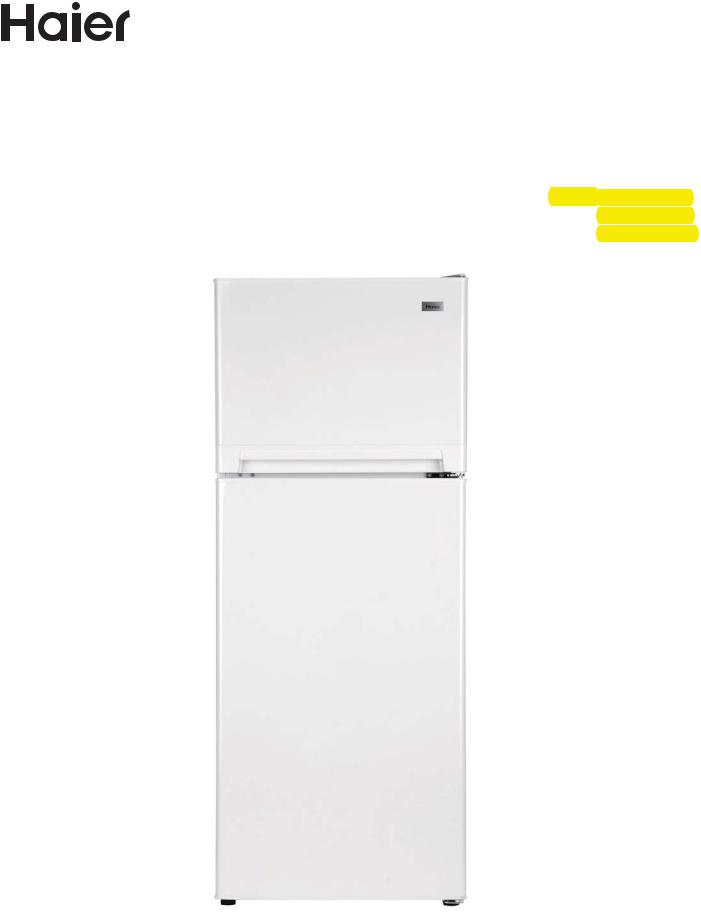
Frost-Free Refrigerator/Freezer
Frost-Libérent
Réfrigérateur/Congélateur
Frost-Libera
Refrigerador/Congelador
User Manual Guide de l’Utilisateur Manual del Usuario
Model HA10TG31SS |
HA10TG31SB
HA10TG31SW

TABLE OF CONTENTS |
|
SAFETY INFORMATION |
|
Important Safety Instructions .................................................................................................................. |
2-3 |
SET UP & USE |
|
Electrical Requirements ................................................................................................................................ |
4 |
Installation Guide....................................................................................................................................... |
4-5 |
Accessories.................................................................................................................................................... |
6 |
Parts & Features............................................................................................................................................. |
7 |
Door Alignment.......................................................................................................................................... |
8-9 |
Features and Use .................................................................................................................................. |
10-11 |
Food Storage Information .......................................................................................................................... |
12 |
CLEANING AND CARE |
|
Proper Care and Maintenance.............................................................................................................. |
13-14 |
TROUBLE SHOOTING & WARRANTY |
|
Normal Operating Sounds.......................................................................................................................... |
15 |
Troubleshooting.................................................................................................................................... |
16-17 |
Customer Service ....................................................................................................................................... |
18 |
Limited Warranty ........................................................................................................................................ |
19 |
ENGLISH
PRODUCT REGISTRATION
Thank you for purchasing our Haier
product. This easy-to-use manual will guide you in getting the best use out of your product. Remember to record the model and serial numbers. They are on the backside or inside of the product.
Model number
Serial number
Date of purchase
Staple your receipt to your manual. You will need it to obtain warranty service.
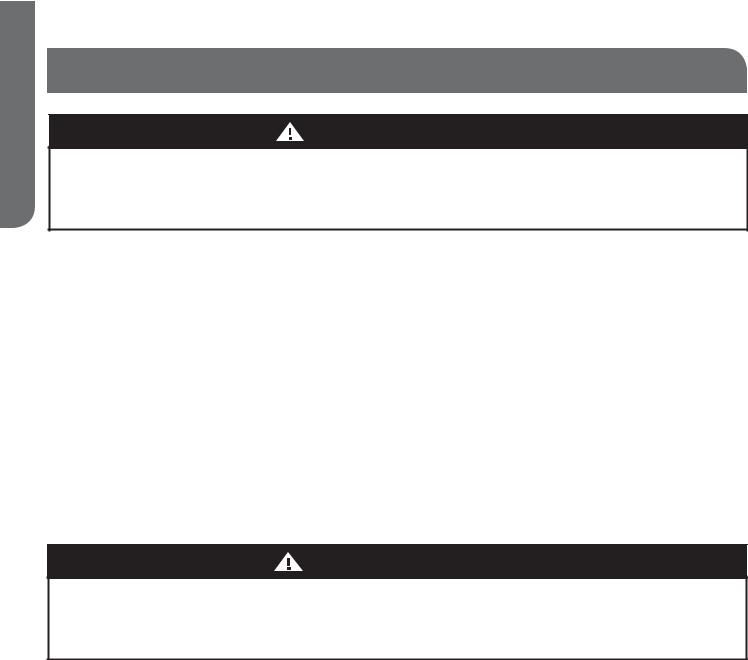
ENGLISH
IMPORTANT SAFETY INSTRUCTIONS
WARNING
READ ALL INSTRUCTIONS BEFORE USING THIS APPLIANCE:
WHEN USING THIS APPLIANCE, ALWAYS EXERCISE BASIC SAFETY
PRECAUTIONS, INCLUDING THE FOLLOWING:
NOTE: If the refrigerator has been placed in a horizontal or tilted position for any period of time, wait 24 hours before plugging the unit in.
1)Use this appliance only for its intended purpose as described in this use and care guide.
2)This refrigerator must be properly installed in accordance with the installation instructions before it is used. See Electrical Requirements in the Set Up & Use section.
3)This refrigerator should not be recessed or built-in an enclosed cabinet. It is designed for freestanding installation only.
4)Never unplug your refrigerator by pulling on the power cord. Always grasp the plug firmly and pull straight out from the outlet.
5)Repair or replace immediately, all electric service cords that have become frayed or otherwise damaged. Do not use a cord that shows cracks or abrasion damage along its length, the plug or the connector end.
6)If your old refrigerator is not being used, we recommend that you remove the doors. This will reduce the possibility of danger to children.
WARNING
AFTER YOUR REFRIGERATOR IS IN OPERATION, DO NOT TOUCH THE COLD SURFACES IN THE FREEZER COMPARTMENT, PARTICULARLY WHEN HANDS ARE DAMP OR WET. SKIN MAY ADHERE TO THESE EXTREMELY COLD SURFACES.
7)Do not refreeze foods, that have been thawed completely. The United States Department of Agriculture in Home and Garden Bulletin No. 69 reads:
"…You may safely refreeze frozen foods that have thawed if they still contain ice crystals or if they are still cold, below 40°F."
"…Thawed ground meats, poultry, or fish that have any off-odor or off-color should not be refrozen and should not be eaten. Thawed ice cream should be discarded. If the odor or color of any food is poor or questionable, discard it. The food may be dangerous to eat."
"…Even partial thawing and re-freezing can reduce the eating quality of foods, particularly fruits, vegetables, and prepared foods. The eating quality of red meats is affected less than that of many other foods. Use refrozen foods as soon as possible to save as much of their eating quality as you can."
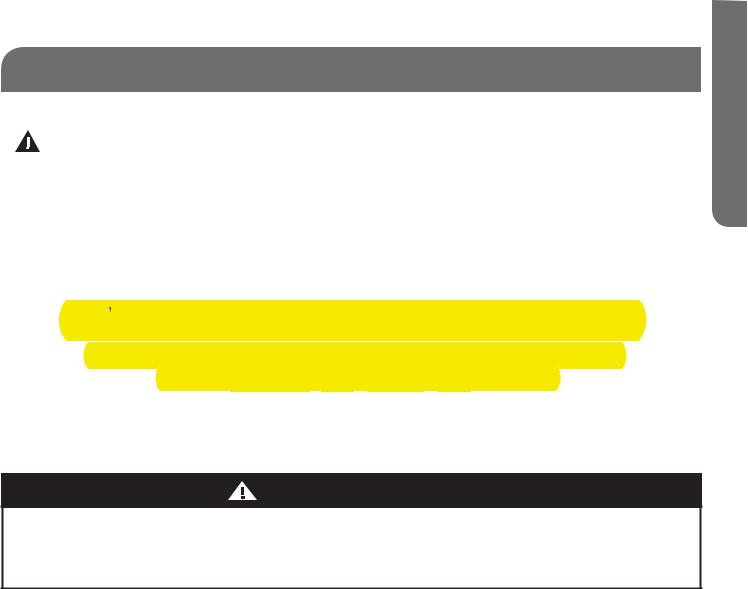
IMPORTANT SAFETY INSTRUCTIONS CONT.
8) Do not use any electrical device or any sharp instrument in defrosting your refrigerator. DANGER—Risk of Fire or Explosion. Flammable Refrigerant Used. Do Not Use Mechanical
Devices to Defrost Refrigertor or Freezer. Do Not Puncture Refrigerant Tubing.
9)Unplug your refrigerator before cleaning or before making any repairs.
NOTE: If for any reason this product requires service, the component parts shall be replaced with like components and that servicing shall be done by factory authorized service personnel, so as to minimize the risk of possible ignition due to incorrect parts or improper service.
10)Do not operate your refrigerator in the presence of explosive fumes.
SAVE THESE INSTRUCTIONS |
CAUTION -Risk of Fire or Explosion |
Dispose of property in accordance with Federal or Local Regulations. Flammable refrigerant used.
DANGER
RISK OF CHILD ENTRAPMENT. BEFORE YOU THROW AWAY YOUR OLD REFRIGERATOR OR FREEZER, TAKE OFF THE DOORS. LEAVE THE SHELVES IN PLACE SO THAT CHILDREN MAY NOT EASILY CLIMB INSIDE.
ENGLISH
PAGE 3 SAFETY INFORMATION
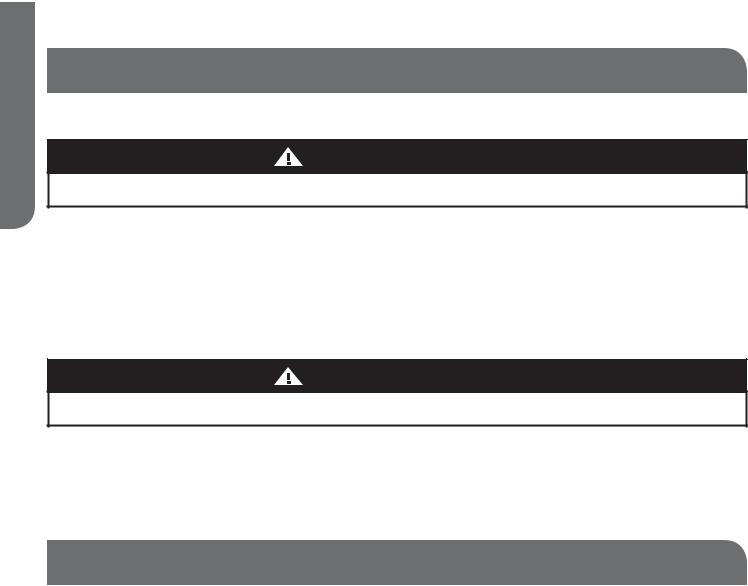
ENGLISH
ELECTRICAL REQUIREMENTS
GROUNDING INSTRUCTIONS
WARNING
ELECTRICAL REQUIREMENT - SHOCK HAZARD
! !# proper grounding to power the refrigerator.
$ ! % ! ' %% ! ! ! accommodate a two prong outlet. This is a dangerous practice since it provides no effective grounding for the refrigerator and may result in shock hazard.
USE OF EXTENSION CORDS
WARNING
USE OF EXTENSION CORDSPOTENTIAL SAFETY HAZARD
$ ! % ( ' ! ' % % * + ! ! ' ' ! If it is necessary to use an extension cord, use only a 3-wire extension cord that has a 3-blade
grounding plug and a 3-slot outlet that will accept the plug. The marked rating of the extension cord must be equal to or greater than the electrical rating of the appliance. DO NOT USE EXTENSION
CORD LONGER THAN 12 FT.
INSTALLATION GUIDE
INSTALLATION LIMITATIONS
/ ' ' % % ! $ % ' * % ! ' source, e.g. radiators, baseboard heaters, cooking appliances, etc. Any floor unevenness should be corrected with the leveling legs located on the front bottom corners of the refrigerator.
UNPACKING YOUR REFRIGERATOR
1.Remove all packaging material. This includes the corrugated base and all adhesive tape holding the refrigerator accessories inside and outside.
2.Inspect and remove any remains of packing, tape or printed materials before powering on the refrigerator.
3.If your refrigerator comes with smooth or stainless steel doors, please remove the clear film before turning it on for the first time. When removing the film, do not pull the film straight down as this could result in misaligned doors.
4.It is normal for the freezer door to be positioned slightly higher than the top of the cabinet when the refrigerator is first installed. This positioning is done at the factory to ensure a proper gasket seal once the door is weighted with food items.
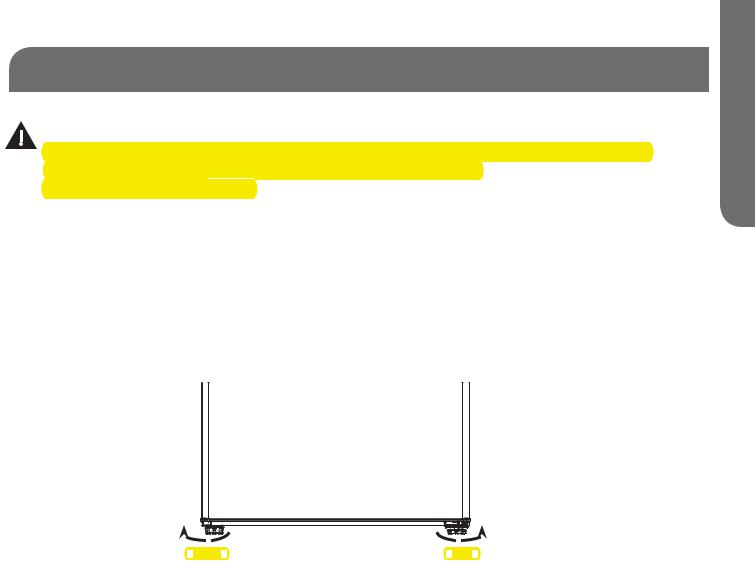
INSTALLATION GUIDE CONT.
CAUTION
Riskof Fire or Explosiondue topuncture of refrigeranttubing.Flammable refrigerant used.
Handle with care when movingrefrigeratortoavoideither damaging the refrigerant tubing |
or increasingthe riskof a leak.
LEVELING YOUR REFRIGERATOR
; Your refrigerator has two leveling legs that are located in the front bottom corners of your refrigerator After properly placing your refrigerator under its <nal position, you can level your refrigerator.
; Leveling legs can be adjusted by turning them counterclockwise to raise your refrigerator or by turnin them clockwise to lower your refrigerator. The refrigerator door will close easier when the leveling leg are extended.
ENGLISH
|
LOWER |
|
|
|
RAISE |
|
PROPER AIR CIRCULATION
; To ensure your refrigerator works at the maximum e=ciency it was designed for, you should install it i a location where there is proper air circulation, plumbing and electrical connections Your refrigerato is not designed to operate in temperatures below 55>F (12>C ) or above 95>F (35>C).
; Do not install your refrigerator in any location not properly insulated or heated, e.g. garage, etc Keep out of direct sunlight and away from heating sources such as radiators, heaters, and cookin appliances.
; The following are recommended clearances around the refrigerator:
Sides……………1” (25 mm) |
Top.................... |
1" (25 mm) |
Back.................. |
2" (50mm) |
PAGE 5 SET UP & USE

ENGLISH
ACCESSORIES
The following accessories are available:
;Glass Shelf for the Fresh Food Section
;Wire Shelf for Freezer Compartment
;Replacement LED Lighting
To order accessories, call 1-877-337-3639 or visit us at www.haieramerica.com/support
PAGE 6 SET UP & USE
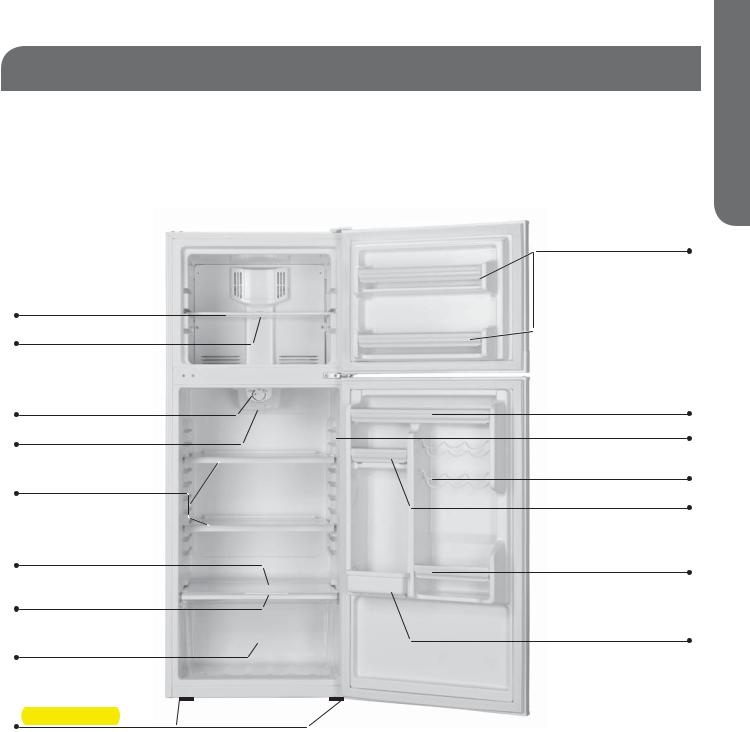
PARTS & FEATURES
Freezer Shelf
Air Flow Control
Adjustable
Temperature
Control
Interior Light
Full-Width
Glass Shelves
Clear Glass
Crisper Cover
Crisper Humidity
Control
Clear Crisper
Leveling Legs
ENGLISH
Full-Width Freezer
Door Shelves
Full-Width Door Shelf
Light Switch
Can Storage
Half-Width Shelf
Half-Width Shelf,
2 Liter Bottle Storage
Compartment
Gallon Storage
Compartment
PAGE 7 SET UP & USE

ENGLISH
DOOR ALIGNMENT
FREEZER DOOR
1.Remove hinge cover screw. (Fig. 1)
2.Remove the top hinge cover.
3.Loosen the top hinge screws using a Phillips head screwdriver.
4.Adjust the door or put a spacer in between and then tighten the screws.
5.Replace the top hinge cover.
Hinge cover
Fig. 1 |
Top hinge |
|
REVERSING THE DOOR SWING
Left/right door opening method:
This product allows you to reverse the door opening from left to right and back. You can select your preference of door opening by following the procedure to make the change.
4.Dismantle two screws of the central hinge, lift it and take oJ the central hinge, and keep them in a safe place. (see <g. 2)
5.Remove the adhesive tape on refrigerator door, lift it and take refrigerator door, and carefully put it aside.
6.Remove the doorstoppers from the refrigerator and freezer doors.
7.Insert left side doorstopper (provided in your packing) on the left side bottom hole of the refrigerator door and on the left side bottom hole of the freezer door. Fasten with screws provided.
Fig. 2
Dismantling: (see <g. 1 and <g. 2)
1.A=x refrigerator and freezer door by sticking adhesive tape on both sides to hold doors in place.
2.As shown in <g. 1, dismantle the hinge cover on the upper part of freezer door with a Phillips head screwdriver. Then remove the three screws that hold the hinge. Take out the hinge by pulling it vertically, and keep it in a safe place.
3.Remove the adhesive tape on freezer door, lift it and take oJ the door, and carefully put it aside.
screw holes
doorstopper (right side)

















 middle pivot pin
middle pivot pin
central hinge
PAGE 8 SET UP & USE
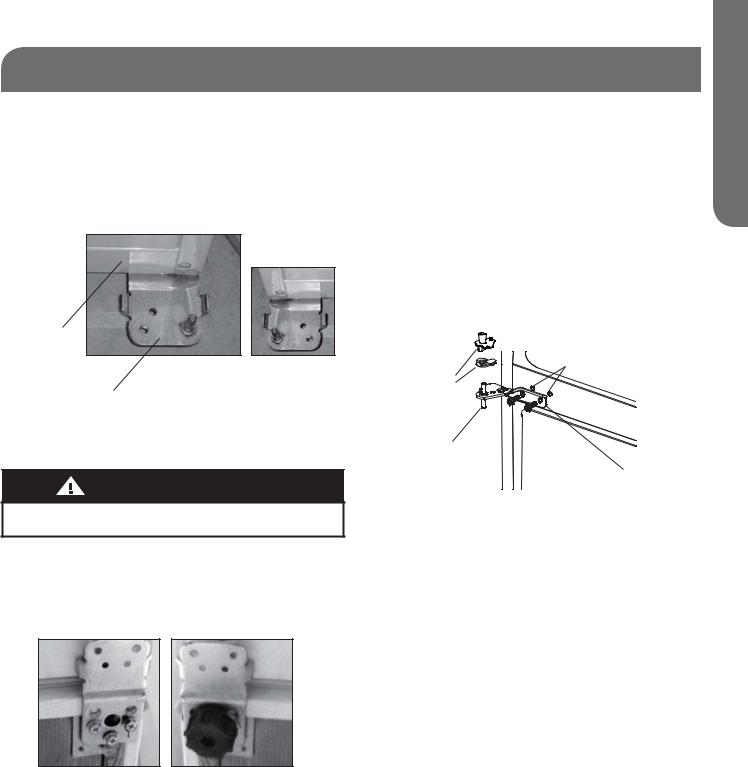
DOOR ALIGNMENT CONT.
REINSTALLATION
1.Remove the lower pivot pin from the lower hinge by turning counter clockwise. Move the pin to the opposite hole and tighten. (see below) (Fig. 3 and Fig. 4)
Fig. 3
bottom of unit
 lower pivot pin
lower pivot pin
bottom hinge
2.Tilt refrigerator on a 45-degree angle to have access to the bottom front.
CAUTION
Two People Required.
3.Remove both left and right front feet from bottom.
4.Loosen the screws holding the bottom hinge and remove it.
6.To install refrigerator door: Line up the left bottom hole of the refrigerator compartment door over the bottom hinge pin. Move door forward to make it straight and align with central hinge. Install the central hinge again, and turn the hinge axle until it completely enters the door body. Secure it with the screws provided. (see <g. 4)
NOTE: Remove plugs from doorframe and install on other side.
Fig. 4 |
|
|
screw |
doorstopper |
holes |
(left side) |
|
middle |
|
pivot pin |
|
central hinge
7.To install freezer door: Line up left bottom hole of the door over the central hinge middle pin. Move door forward to make it straight and align with freezer compartment. Place over left side the top hinge, align holes with hole on the refrigerator top and tighten with the screws provided.
5.Align the holes in the bottom hinge to the corresponding holes on the opposite side of the cabinet. Insert and tighten the screws. Reinstall both front feet.
ENGLISH
PAGE 9 SET UP & USE
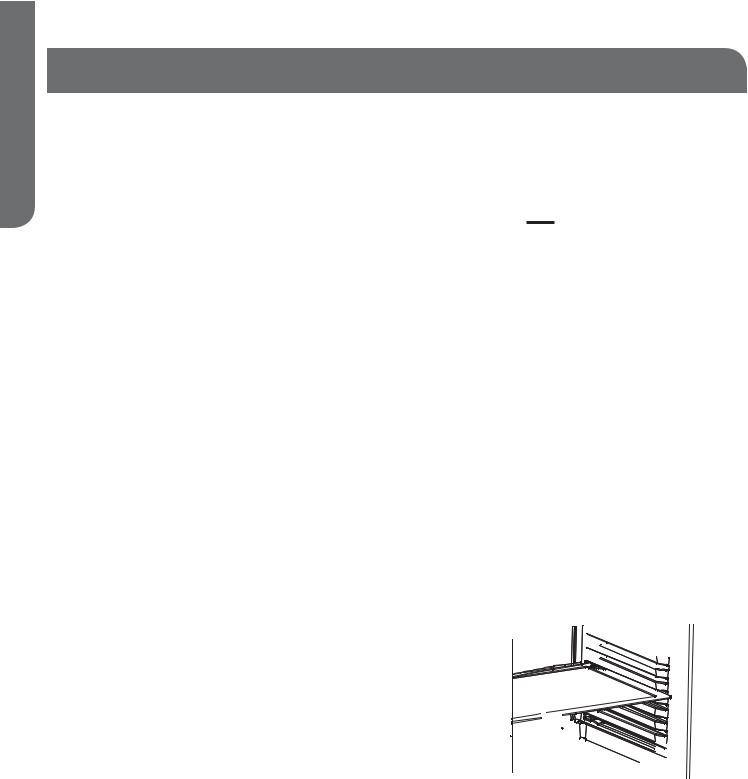
ENGLISH
FEATURES AND USE
ADJUSTABLE TEMPERATURE DIAL
Your refrigerator will automatically maintain the temperature level you select. The temperature control has 7 settings. COLD is the warmest setting. COLDER is the coldest setting. Unplugging the unit stops the cooling in both the refrigeration and freezer sections. At <rst,set the dial to the 4th indicator marking (middle setting), and allow 24 hours to pass before adjusting the temperature to your needs.
To adjust the temperature range in the cold setting, turn the temperature dial in a clockwise direction. For normal operating conditions, keep the dial halfway between cold and coldest. For your convenience, the factory presets the control at normal operating conditions.
NOTE: If the refrigerator has been placed in a horizontal or tilted position for any period of time wait 24 hours before plugging the unit in.
FREEZER SECTION
Your freezer compartment is equipped with adjustable airQow control. For your convenience, airQow is preset by the factory to the colder setting. There is also an option to adjust the settings, either to cold or to coldest.
REFRIGERATOR SECTION
INTERIOR LIGHT
Your refrigerator is equipped with an interior light in the fresh food section for you to easily locate your food.
FROSTFREE REFRIGERATOR-FREEZER
You should never need to defrost your freezer, as it automatically defrosts any ice build-up that may occur.
 DANGER— Risk of Fire or Explosion. Flammable Refrigerant Used. Do Not Use
DANGER— Risk of Fire or Explosion. Flammable Refrigerant Used. Do Not Use
Mechanical Devices to Defrost Refrigertor or Freezer. Do not Puncture Refrigerant Tubing.
REFRIGERATOR INTERIOR SHELVES
(Shelves may vary by model)
The shelves of your refrigerator were designed with you in mind. Their varied adjustability allows you to satisfy your personal storage needs.
To remove or adjust a full-width slide-out shelf: (see <g. 5)
1.Gently tilt the shelf up and slide forward until the shelf has been completely removed.
2.To replace the shelf, select the desired setting and gently slide the shelf back until it rests in the locking position.
Fig. 5
PAGE 10 SET UP & USE
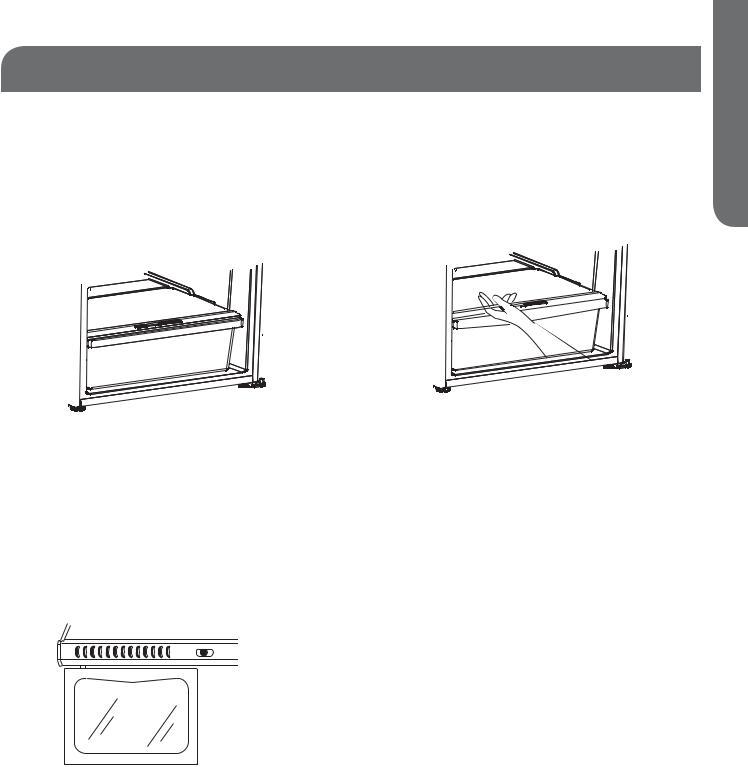
FEATURES AND USE CONT.
CRISPERS AND CRISPER COVER
To remove and install the crisper: (see <g. # 6)
1.Grip the crisper <rmly and slide out completely.
2.Replace the crisper by placing the crisper properly in position and gently sliding it back into place.
Fig. 6
Your refrigerator may be equipped with a slide control to raise or lower the humidity levels or your crispers. This feature will increase the storage
life of your fruits and vegetables. Simply adjust the controls to the appropriate setting for items you are storing in the crispers. Low settings allow moist air to exit the crisper, for optimum storage of fruit and/or vegetables that have skins. High settings retains moist air in the crisper, for optimum storage of leafy fresh vegetables.
REMOVING OR REPLACING THE CRISPER COVER
1.Carefully grasp the crisper cover and slide out to remove. (Fig. 7)
Fig. 7
2.To replace, slide the rear of the crisper cover into the right and left slots above the crisper area and gently slide back into place.
ENGLISH
PAGE 11 SET UP & USE

ENGLISH
FOOD STORAGE INFORMATION
FRESH FOOD:
X % % ! ' ! be sure to wrap or store food in airtight and moisture proof material unless otherwise noted. This will ensure proper shelf life and prevent the transfer of odors and tastes.
X ' % $ ! ! spills.
Z ! ! their original carton to maximize shelf life.
[ ! ! ! ! ! ! in sealed plastic bags before storing in the refrigerator.
! ! ' bags or containers.
\ %* $ ! ! ! ! ! and then stored in plastic bags or containers.
] % ! ! ! ' % in the refrigeration. This will prevent unnecessary energy use.
[ % ! ! ! ! * purchased.
X % % ! ' keep in the original packaging or rewrap as necessary.
These are some suggestions for safe storage:
^ ' _` { *! | % _` { *^ ! ^ _ { *
/ }~ _ { */ !}^ ! •_ € { *
For detailed storage chart visit FDA website: www.cfsan.fda.gov/~dms/fttstore.html
FROZEN FOOD
X ' % $ ! ! spills.
] % ! ! ! ' % in the freezer. This will prevent unnecessary energy use.
X packaging or rewrap as necessary.
% + ‚ ' ' packaging. All foods must be in packages, that do not allow the flow of air or moisture in, or out. Improper storage will result in odor and taste transfer and will result in the drying out of the improperly packaged food.
[ ' ' ' % proper storage.
' ~ ' ! „ Plastic containers with air tight lids Heavy duty aluminum foil
Plastic wrap made from saran film Self-sealing plastic bags
{ % + ! % !} ! % !
… ' ! ! % + ! marked on the packaging.
These are some suggestions for safe storage:
† { _ ‡[ / ' ' % _ ˆ] ‰ _ ‡! † * $ _ ‡^ ‡ _ ˆ/ ˆ _ `^ ' † * ˆ _ Š
For detailed storage chart visit FDA website: www.cfsan.fda.gov/~dms/fttstore.html
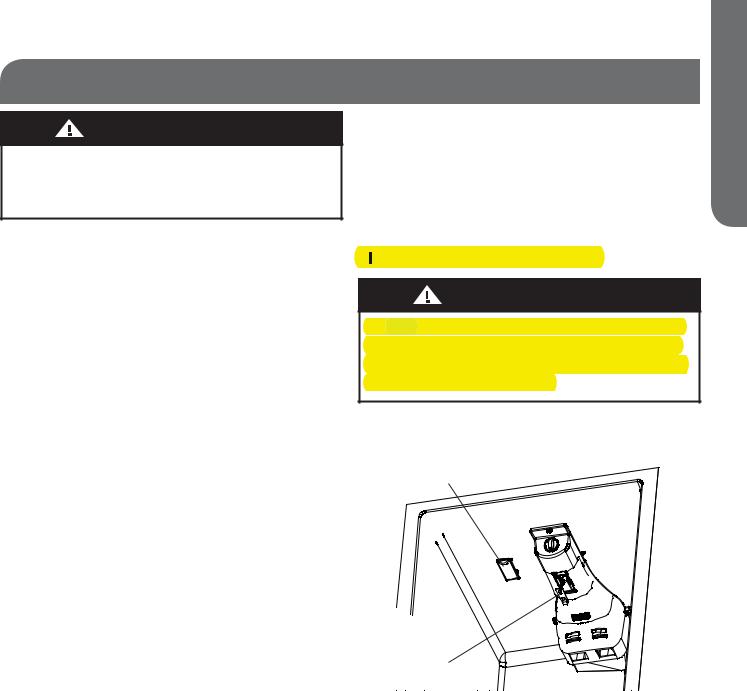
PROPER CARE AND MAINTENANCE
WARNING
Before cleaning your refrigerator, ALWAYS unplug it from the power source. Failure to heed this warning could result in injury or death from electric shock.
NOTE: Before using any cleaning products, be sure to read the manufacturer’s instructions and warnings. This will help avoid personal injury or damage to property.
INTERIOR CLEANING:
Prepare a cleaning solution of 3-4 tablespoons of baking soda mixed with warm water. Use a sponge or soft cloth, dampened with the cleaning solution, to wipe the inside of your refrigerator.
Avoid cleaning any cold glass (shelves, crisper cover glass, etc.) with hot water. The glass can break and cause personal injury. Handle all glass parts with care at all times.
Do not attempt to wash any parts in a dishwasher.
Do not use harsh chemicals, ammonia, chlorine bleach, concentrated detergent, solvents, abrasives or metal scouring pads to clean your refrigerator, inside or out. They can damage and/ or discolor the refrigerator <nish.
EXTERIOR CLEANING:
Use a clean, soft, lightly dampened cloth with kitchen appliance wax or a mild detergent to clean the exterior of the refrigerator.
Use a clean, soft, lightly dampened cloth with warm soapy water to clean the handles and trim. Use a clean, soft towel to dry.
For stainless steel models, use a dry cloth and stainless steel polish.
Door gaskets should be cleaned every three months following the instructions for interior cleaning. Clean gaskets will maintain a better seal than dirty gaskets. Lightly apply petroleum jelly to the hinge side of the gaskets to keep the gasket pliable and assure a good seal.
Never use a dirty cloth to clean the exterior of the refrigerator. Dirty cloths may leave residue on the refrigerator that can damage the <nish.
Also, avoid the use of harsh chemicals, ammonia, chlorine bleach, concentrated detergent, solvents, abrasives or metal scouring pads to clean the outside of the refrigerator.
LEDI Lighting REPLACEMENT
WARNING
Do not change the LED light by yourself , please contact the after-sale service for replacement. Failure to heed this warning could result in injury or death from electric shock.
Light cover
LED
ENGLISH
PAGE 13 CLEANING AND CARE

ENGLISH
PROPER CARE AND MAINTENANCE
POWER INTERRUPTIONS
In the event of a power interruption, unplug your refrigerator from the power source. Avoid opening the doors until after power has been restored. Your refrigerator will maintain a cold temperature for longer if door opening is avoided or kept to a minimum.
Once power has been restored, plug your refrigerator back into the power source and inspect food in the refrigerator for spoilage or thawing. Cleaning your refrigerator after a
prolonged power outage is strongly recommended to avoid odors and potential health hazards due to thawing.
VACATION
For long vacations or absences, unplug your refrigerator and remove all food from it. Clean the refrigerator, including the gaskets, according
to the Proper Care and Maintenance section. Leave the doors propped open to allow air to circulate inside the refrigerator.
MOVING
Before moving your refrigerator, empty the food from it and use adhesive tape to secure all loose items such as shelves, door bins and racks,
crispers and pans, etc. and unplug it. Always move the refrigerator in an upright position in order to avoid damaging the sealed refrigerant system.
PAGE 14 CLEANING AND CARE
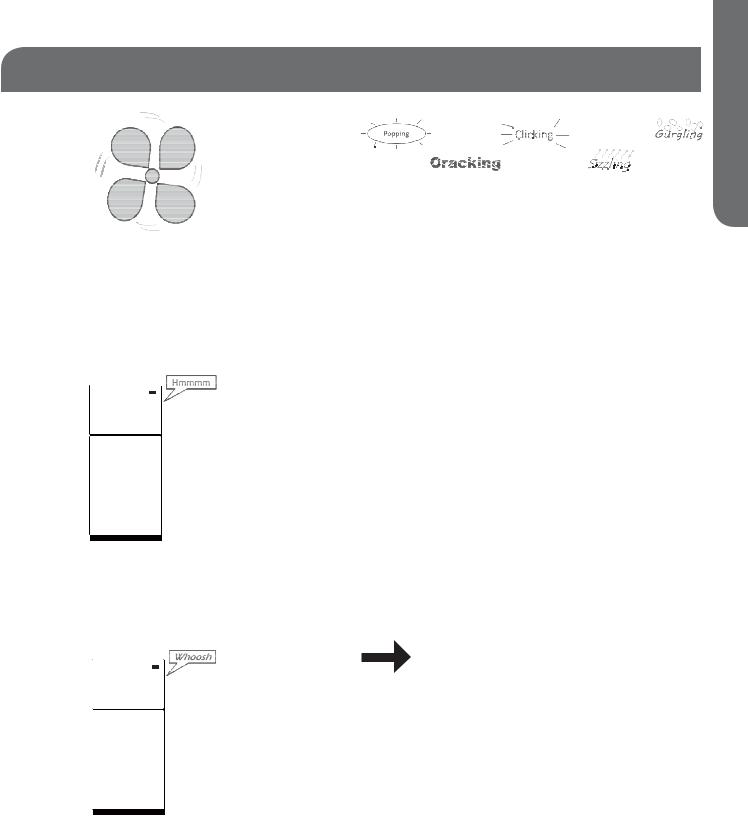
NORMAL OPERATING SOUNDS
ENGLISH
Whirring
There is a fan inside your refrigerator which helps to maintain the temperature you have selected. Whirring is common when the refrigerator is <rst plugged in, when the doors have been opened often or for an extended period of time and when a large amount of food has been added.
Humming
This is a common noise that comes from the compressor and is a part of making your refrigerator run e=ciently.
Whooshing
It is possible that you may hear a whooshing noise when closing the doors. This is no cause for concern. It is simply the pressure in the refrigerator equalizing.
; There are a lot of things going on in your refrigerator at any given time. Additional noises you may hear, and possible causes include:
; Gurgling is most likely due to the circulation of refrigerant through the cooling coils.
; Sizzling or popping sounds can be frost melting and falling onto the defrost heater during the defrost cycle.
; Clicking or chirping may be heard as the compressor attempts to re-start.
; Cracking or popping noises may be from the expansion and contraction of cooling coils during and after the defrost cycle.
; Also, when your refrigerator is <rst plugged in, the foam insulation in the walls will cool and
contract, which can result in cracking or popping noises.
If the refrigerator has been placed in a horizontal position for any period of time, wait 24 hours after returning it to the upright position before plugging it in.
IMPORTANT
During the automatic defrost cycle, you may notice a red glow in the vents on the back wall of your freezer compartment. This is normal during the defrost cycle.
PAGE 15 TROUBLE SHOOTING & WARRANTY

ENGLISH
TROUBLESHOOTING
PROBLEM |
|
|
|
POSSIBLE CAUSE(S) |
|
|
|
|
|
|
|
|
|
|
|
|
|
|
|
|
|
|
|
|
|
SOLUTION |
||||||||||||||||||||||||||||||||||||||||||||||||||||||||||
Refrigerator does |
Refrigerator is unplugged |
Plug power cord into power source |
||||||||||||||||||||||||||||||||||||||||||||||||||||||||||||||||||||||||||||||||||
not run |
||||||||||||||||||||||||||||||||||||||||||||||||||||||||||||||||||||||||||||||||||||
|
|
|
|
|
|
|
|
|
|
|
|
|
|
|
|
|
|
|
|
|
|
|
|
|
|
|
|
|
|
|
|
|
|
|
|
|
|
|
|
|
|
|
|
|
|
|
|
|
|
|
|
|
|
|
|
|
|
|
|
|
|
|
|
|
|
|
|
|
|
|
|
|
|
|
|
|
|
|
|
|
|
|
||
|
Breaker is tripped or unplugged/Fuse is |
Reset / Turn on breaker or replace fuse |
||||||||||||||||||||||||||||||||||||||||||||||||||||||||||||||||||||||||||||||||||
|
blown |
|||||||||||||||||||||||||||||||||||||||||||||||||||||||||||||||||||||||||||||||||||
|
|
|
|
|
|
|
|
|
|
|
|
|
|
|
|
|
|
|
|
|
|
|
|
|
|
|
|
|
|
|
|
|
|
|
|
|
|
|
|
|
|
|
|
|
|
|
|
|
|
|
|
|
|
|||||||||||||||||||||||||||||||
|
Refrigerator is in defrost mode |
Wait |
|
|
|
|
|
about |
|
30 |
|
|
|
minutes for |
|
|
|
|
defrost |
|
|
|
cycle |
|
|
to |
|
end |
|
|||||||||||||||||||||||||||||||||||||||||||||||||||||||
|
|
|
|
|
|
|
|
|
|
|
|
|
|
|
|
|
|
|
|
|
||||||||||||||||||||||||||||||||||||||||||||||||||||||||||||||||
|
and |
|
|
|
cooling |
|
|
|
|
system |
|
|
to |
|
|
|
|
restart |
|
|
|
|
|
|
|
|
|
|
|
|
|
|
|
|
|
|||||||||||||||||||||||||||||||||||||||||||||||||
|
|
|
|
|
|
|
|
|
|
|
|
|
|
|
|
|
|
|
|
|
|
|
|
|
|
|
|
|
|
|
|
|
|
|
|
|
|
|
|
|
|
|
|
|
|
|
|
|
|
|
|
|
|
|||||||||||||||||||||||||||||||
|
|
|
|
|
|
|
|
|
|
|
|
|
|
|
|
|
|
|
|
|
|
|
|
|
|
|
|
|
|
|
|
|
|
|
|
|
|
|||||||||||||||||||||||||||||||||||||||||||||||
|
|
|
|
|
|
|
|
|
|
|
|
|
|
|
|
|
|
|
|
|
|
|
|
|
|
|
|
|
|
|
|
|
|
|
|
|
|
|
|
|
|
|||||||||||||||||||||||||||||||||||||||||||
|
|
|
|
|
|
|
|
|
|
|
|
|
|
|
|
|
|
|
|
|
|
|
|
|
|
|
|
|
|
|
|
|
|
|
|
|
|
|
|
|
|
|
|
|
|
|
|
|
|
|
|
|
|
|
|
|
|
|
|
|
|
|
|
|
|
|
|
|
|
|
|
|
|
|
|
|
|
|
|
|
|
|
|
|
|
Temperature control is not set low |
Turn temperature knob clockwise to adjust to a |
||||||||||||||||||||||||||||||||||||||||||||||||||||||||||||||||||||||||||||||||||
|
enough |
lower temperature; allow 24 hours to adjust |
||||||||||||||||||||||||||||||||||||||||||||||||||||||||||||||||||||||||||||||||||
Refrigerator or |
Doors opened frequently or left open |
Keep door closed / Check that a package isn’t |
||||||||||||||||||||||||||||||||||||||||||||||||||||||||||||||||||||||||||||||||||
freezer is too warm |
preventing door from closing |
|||||||||||||||||||||||||||||||||||||||||||||||||||||||||||||||||||||||||||||||||||
|
Warm food added recently |
Allow time for food and refrigerator to cool |
||||||||||||||||||||||||||||||||||||||||||||||||||||||||||||||||||||||||||||||||||
|
|
|
|
|
|
|
|
|
|
|
|
|
|
|
|
|
|
|
|
|
|
|
|
|
|
|
|
|
|
|
|
|
|
|
|
|
|
|
|
|
|
|
|
|
|
|
|
|
|
|
|
|
|
|
|
|
|
|
|
|
|
|
|
|
|
|
|
|
|
|
|
|
|
|
|
|
|
|
|
|
|
|
|
|
|
Items against back of compartments |
Store items only inside the trim of the glass |
||||||||||||||||||||||||||||||||||||||||||||||||||||||||||||||||||||||||||||||||||
|
shelves; don’t place items against sides of the |
|||||||||||||||||||||||||||||||||||||||||||||||||||||||||||||||||||||||||||||||||||
|
are blocking proper airQow |
|||||||||||||||||||||||||||||||||||||||||||||||||||||||||||||||||||||||||||||||||||
|
compartments or directly in front of any vents |
|||||||||||||||||||||||||||||||||||||||||||||||||||||||||||||||||||||||||||||||||||
|
|
|
|
|
|
|
|
|
|
|
|
|
|
|
|
|
|
|
|
|
|
|
|
|
|
|
|
|
|
|
||||||||||||||||||||||||||||||||||||||||||||||||||||||
|
|
|
|
Refrigerator |
|
|
|
|
|
|
is |
|
|
in |
|
|
|
adapti |
|
vee |
|
|
|
defrost |
|
|
mode |
|
|
|
This |
|
|
|
is |
|
|
|
normal |
|
|
|
, |
|
defrost |
|
|
|
|
|
|
cycle |
|
|
|
|
|
lastsabout |
|
|
|
30 |
|
|
|
|
||||||||||||||||||
|
|
|
|
|
|
|
|
|
|
|
|
|
|
|
|
|
|
|
|
|
|
|
|
|
|
|
|
|
|
|
|
|
|
|
|
|
|
|
|
|
|
|
||||||||||||||||||||||||||||||||||||||||||
|
|
|
|
|
|
|
|
|
|
|
|
|
|
|
|
|
|
|
|
|
|
|
|
|
minutes |
|
|
|
|
|
|
|
|
|
|
|
|
|
|
|
|
|
|
|
|
|
|
|
|
|
|
|
|
|
|
|
|
|
|
|
|
|
|
|
|
|
|
|||||||||||||||||
|
|
|
|
|
|
|
|
|
|
|
|
|
|
|
|
|
|
|
|
|
|
|
|
|
|
|
|
|
|
|
|
|
||||||||||||||||||||||||||||||||||||||||||||||||||||
|
|
|
|
|
|
|
|
|
|
|
|
|
|
|
|
|
|
|
|
|
|
|
|
|
|
|
|
|
|
|
|
|||||||||||||||||||||||||||||||||||||||||||||||||||||
|
|
|
|
|
|
|
|
|
|
|
|
|
|
|
|
|
|
|
|
|
|
|
|
|
|
|
|
|
|
|
|
|
|
|
|
|
|
|
|
|
|
|
|
|
|
|
|
|
|
|
|
|
|
|
|
|
|
|
|
|
|
|
|
|
|
|
|
|
|
|
|
|
|
|
|
|
|
|
|
|
|
|
|
|
Refrigerator or |
Temperature control is set too low |
Turn knob counter-clockwise to change to a |
||||||||||||||||||||||||||||||||||||||||||||||||||||||||||||||||||||||||||||||||||
freezer is too cold |
warmer setting; allow 24 hours to adjust |
|||||||||||||||||||||||||||||||||||||||||||||||||||||||||||||||||||||||||||||||||||
|
|
|
|
|
|
|
|
|
|
|
|
|
|
|
|
|
|
|
|
|
|
|
|
|
|
|
|
|
|
|||||||||||||||||||||||||||||||||||||||||||||||||||||||
|
|
|
|
|
|
|
|
|
|
|
|
|
|
|
|
|
|
|
|
|
|
|
|
|
|
|
|
|
|
|
|
|
|
|
|
|
|
|
|
|
|
|
|
|
|
|
|
|
|
|
|
|
|
|
|
|
|
|
|
|
|
|
|
|
|
|
|
|
|
|
|
|
|
|
|
|
|
|
|
|
|
|
|
|
Refrigerator |
Normal when <rst plugged in |
Allow 24 hours for the refrigerator to cool down |
||||||||||||||||||||||||||||||||||||||||||||||||||||||||||||||||||||||||||||||||||
compressor runs |
Warm or large amounts of food added |
This is normal |
||||||||||||||||||||||||||||||||||||||||||||||||||||||||||||||||||||||||||||||||||
frequently or for |
|
|
|
|
|
|
|
|
|
|
|
|
|
|
|
|
|
|
|
|
|
|
|
|
|
|
|
|
|
|
|
|
|
|
|
|
|
|
|
|
|
|
|
|
|
|
|
|
|
|
|
|
|
|
|
|
|
|
|
|
|
|
|
|
|
|
|
|
|
|
|
|
|
|
|
|
|
|
|
|
|
|
|
|
Door is left open |
Ensure that door is not being held open by an |
|||||||||||||||||||||||||||||||||||||||||||||||||||||||||||||||||||||||||||||||||||
long periods of time |
||||||||||||||||||||||||||||||||||||||||||||||||||||||||||||||||||||||||||||||||||||
item |
||||||||||||||||||||||||||||||||||||||||||||||||||||||||||||||||||||||||||||||||||||
|
|
|
|
|
|
|
|
|
|
|
|
|
|
|
|
|
|
|
|
|
|
|
|
|
|
|
|
|
|
|
||||||||||||||||||||||||||||||||||||||||||||||||||||||
|
Hot weather or frequent openings |
This is normal |
||||||||||||||||||||||||||||||||||||||||||||||||||||||||||||||||||||||||||||||||||
|
Temperature control set to coldest |
Adjust knob to a warmer setting |
||||||||||||||||||||||||||||||||||||||||||||||||||||||||||||||||||||||||||||||||||
|
setting |
|||||||||||||||||||||||||||||||||||||||||||||||||||||||||||||||||||||||||||||||||||
|
|
|
|
|
|
|
|
|
|
|
|
|
|
|
|
|
|
|
|
|
|
|
|
|
|
|
|
|
|
|
|
|
|
|
|
|
|
|
|
|
|
|
|
|
|
|
|
|
|
|
|
|
|
|||||||||||||||||||||||||||||||
Moisture on |
High humidity |
This is normal; Dry surface and adjust |
||||||||||||||||||||||||||||||||||||||||||||||||||||||||||||||||||||||||||||||||||
exterior/interior of |
temperature knob to slightly colder setting |
|||||||||||||||||||||||||||||||||||||||||||||||||||||||||||||||||||||||||||||||||||
|
|
|
|
|
|
|
|
|
|
|
|
|
|
|
|
|
|
|
|
|
|
|
|
|
|
|
|
|
|
|||||||||||||||||||||||||||||||||||||||||||||||||||||||
refrigerator |
|
|
|
|
|
|
|
|
|
|
|
|
|
|
|
|
|
|
|
|
|
|
|
|
|
|
|
|
|
|
|
|
|
|
|
|
|
|
|
|
|
|
|
|
|
|
|
|
|
|
|
|
|
|
|
|
|
|
|
|
|
|
|
|
|
|
|
|
|
|
|
|
|
|
|
|
|
|
|
|
|
|
|
|
Doors opened frequently or left open |
Keep door closed / Check that a package isn’t |
|||||||||||||||||||||||||||||||||||||||||||||||||||||||||||||||||||||||||||||||||||
|
preventing door from closing |
|||||||||||||||||||||||||||||||||||||||||||||||||||||||||||||||||||||||||||||||||||
|
|
|
|
|
|
|
|
|
|
|
|
|
|
|
|
|
|
|
|
|
|
|
|
|
|
|
|
|
|
|
||||||||||||||||||||||||||||||||||||||||||||||||||||||
|
|
|
|
|
|
|
|
|
|
|
|
|
|
|
|
|
|
|
|
|
|
|
|
|
|
|
|
|
|
|
|
|
|
|
|
|
|
|
|
|
|
|
|
|
|
|
|
|
|
|
|
|
|
|
|
|
|
|
|
|
|
|
|
|
|
|
|
|
|
|
|
|
|
|
|
|
|
|
|
|
|
|
|
|
|
Open container of water in refrigerator |
Cover or seal container |
||||||||||||||||||||||||||||||||||||||||||||||||||||||||||||||||||||||||||||||||||
Refrigerator has an |
Food is not sealed or packaged properly |
Re-seal packaging / Place an opened box of |
||||||||||||||||||||||||||||||||||||||||||||||||||||||||||||||||||||||||||||||||||
odor |
baking soda in the refrigerator, replace every |
|||||||||||||||||||||||||||||||||||||||||||||||||||||||||||||||||||||||||||||||||||
|
|
|
|
|
|
|
|
|
|
|
|
|
|
|
|
|
|
|
|
|
|
|
|
|
|
|
|
|
|
|
three months |
|||||||||||||||||||||||||||||||||||||||||||||||||||||
|
Interior needs to be cleaned |
Follow cleaning instructions in Proper Care and |
||||||||||||||||||||||||||||||||||||||||||||||||||||||||||||||||||||||||||||||||||
|
|
|
|
|
|
|
|
|
|
|
|
|
|
|
|
|
|
|
|
|
|
|
|
|
|
|
|
|
|
|
Maintenance section |
|||||||||||||||||||||||||||||||||||||||||||||||||||||
|
|
|
|
|
|
|
|
|
|
|
|
|
|
|
|
|
|
|
|
|
|
|
|
|
|
|
|
|
|
|
|
|
|
|
|
|
|
|
|
|
|
|
|
|
|
|
|
|
|
|
|
|
|
|
|
|
|
|
|
|
|
|
|
|
|
|
|
|
|
|
|
|
|
|
|
|
|
|
|
|
|
|
|
|
Light does not |
Refrigerator is unplugged |
Plug refrigerator in to power source |
||||||||||||||||||||||||||||||||||||||||||||||||||||||||||||||||||||||||||||||||||
come on |
||||||||||||||||||||||||||||||||||||||||||||||||||||||||||||||||||||||||||||||||||||
|
|
|
|
|
|
|
|
|
|
|
|
|
|
|
|
|
|
|
|
|
|
|
|
|
|
|
|
|
|
|
|
|
|
|
|
|
|
|
|
|
|
|
|
|
|
|
|
|
|
|
|
|
|
|
|
|
|
|
|
|
|
|
|
|
|
|
|
|
|
|
|
|
|
|
|
|
|
|
|
|
|
|
||
Switch located at the right side of Fresh
Light switch gets stuck
Food Compartment, make sur e it is in place
e it is in place
LED light broken |
Contact after-sale service for replacement |
PAGE 16 TROUBLE SHOOTING & WARRANTY
